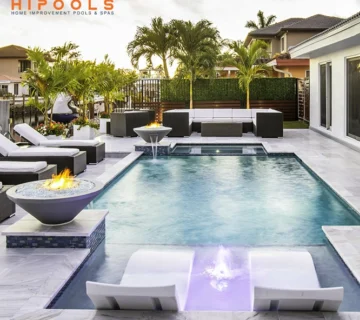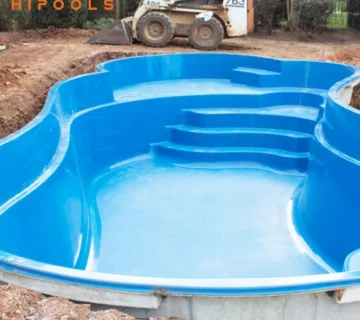When it comes to transforming your backyard into a personal oasis, installing a pool is one of the most exciting and rewarding projects you can undertake. Whether you’re dreaming of an above-ground pool for summer fun or a luxurious in-ground pool for year-round enjoyment, proper planning and installation are key to ensuring your pool is safe, functional, and long-lasting. In this comprehensive guide, we’ll walk you through everything you need to know about pool installation, from site preparation to avoiding common mistakes. Make a splash! At Hi Poolss, we’re passionate about helping you create the pool of your dreams, from design to installation and beyond.

Step-by-Step Guide to Installing an Above Ground Pool
Above-ground pools are a popular choice for homeowners who want a cost-effective and relatively easy-to-install option. Here’s a step-by-step guide to help you get started:
1. Choose the Right Location
– Select a flat, level area in your yard that receives plenty of sunlight.
– Ensure the location is free from underground utilities, tree roots, and overhead power lines.
2. Prepare the Site
– Clear the area of grass, rocks, and debris.
– Level the ground using a shovel, rake, or rented equipment like a plate compactor.
3. Lay the Base
– Spread a layer of sand or a pool pad to create a smooth, even surface.
– Compact the base to prevent shifting or sinking over time.
4. Assemble the Pool Frame
– Follow the manufacturer’s instructions to assemble the metal or resin frame.
– Ensure all parts are securely connected.
5. Install the Pool Liner
– Carefully unfold the liner and position it inside the frame.
– Smooth out wrinkles and ensure the liner fits snugly.
6. Fill the Pool with Water
– Begin filling the pool with water while adjusting the liner to remove any remaining wrinkles.
– Check for leaks or issues as the water level rises.
7. Set Up the Filtration System
– Install the pump, filter, and skimmer according to the manufacturer’s instructions.
– Connect the plumbing and ensure everything is functioning properly.
8. Add Finishing Touches
– Install any additional features, such as ladders or lighting.
– Test the water chemistry and add chemicals as needed.

Step-by-Step Guide to Installing an In-Ground Pool
In-ground pools offer a more permanent and customizable solution for homeowners. While the installation process is more complex, the results are well worth the effort. Here’s how to install an in-ground pool:
| Step | Details |
| Design and Planning | Work with a professional pool designer to create a plan that fits your space and budget. Obtain necessary permits from your local government. |
| Excavation | Mark the pool’s outline on the ground using stakes and string. Use heavy machinery to excavate the area to the required depth and shape. |
| Install the Pool Structure | Concrete Pools: Build the framework and pour the concrete. Fiberglass Pools: Lower the pre-formed shell into the excavation. Vinyl-Lined Pools: Assemble the walls and floor structure. |
| Plumbing and Electrical Work | Install the plumbing system, including pipes, drains, and skimmers. Hire a licensed electrician to handle electrical connections for pumps, lights, and other equipment. |
| Backfilling and Compacting | Fill the space around the pool structure with gravel or soil. Compact the material to provide stability and prevent shifting. |
| Install the Pool Liner or Finish | Vinyl Pools: Install the custom liner. Concrete Pools: Apply the chosen finish (e.g., plaster, tile, or pebble). |
| Fill the Pool with Water | Begin filling the pool with water while monitoring for leaks or issues. Adjust the water chemistry as needed. |
| Landscaping and Final Touches | Add decking, coping, and landscaping around the pool. Install safety features, such as fences or pool covers. |
At Hi Poolss, we offer free estimates, transparent pricing, and customized solutions to fit your budget.
Explore these stunning designs for inspiration to bring your dream pool to life!

Pool Site Preparation and Land Grading
Proper site preparation is the cornerstone of a successful pool installation, laying the groundwork for a safe, durable, and visually appealing pool. The process begins with a thorough evaluation of the terrain. Assessing the slope, soil type, and drainage of your yard is essential to identify potential challenges, such as uneven ground or poor drainage. Addressing these issues early on ensures a solid foundation for your pool, preventing future complications like shifting, cracking, or water pooling around the structure. This initial assessment not only sets the stage for a smooth installation process but also helps you avoid costly repairs down the line.
Once the terrain has been evaluated, the next step is to clear the area of any obstacles. This includes removing trees, rocks, bushes, or existing structures that could interfere with the installation. It’s equally important to check for underground utilities, such as gas lines, electrical cables, or water pipes, to avoid hazardous disruptions or expensive repairs. Clearing the area thoroughly creates a clean slate, allowing you to move forward with confidence and precision.
With the site cleared, the focus shifts to leveling the ground. Using a transit level or laser level, identify the high and low points of the site to determine where grading is needed. Grading the land to create a flat, even surface is critical for the pool’s structural integrity and overall appearance. A level base ensures that the pool sits evenly, preventing issues like water imbalance or structural stress. Once the ground is leveled, the soil must be compacted using a plate compactor to stabilize it and prevent settling over time. For added support, a layer of gravel or sand can be spread across the site, providing a sturdy and durable foundation.
While site preparation and land grading may require significant time and effort, they are essential steps that cannot be overlooked. Proper preparation not only ensures the longevity and stability of your pool but also enhances its aesthetic appeal and functionality. By investing in a well-prepared site, you’re setting the stage for years of enjoyment and relaxation in your backyard oasis.

Plumbing and Electrical Considerations for Pool Installation
Proper plumbing and electrical work are essential for a functional and safe pool. Here’s what to keep in mind:
1. Plumbing
– Plan the layout of pipes, drains, and skimmers to ensure efficient water circulation.
– Use high-quality materials to prevent leaks and corrosion.
– Install a backflow prevention device to protect your water supply.
2. Electrical
– Hire a licensed electrician to handle all electrical connections.
– Install ground fault circuit interrupters (GFCIs) to prevent electrical shocks.
– Ensure all wiring is up to code and properly insulated.
Impact of Climate on Pool Type and Installation
Your local climate plays a significant role in determining the best pool type and installation methods. Consider the following factors:
1. Temperature
– In colder climates, choose materials that can withstand freezing temperatures, such as concrete or fiberglass.
– In warmer climates, opt for materials that resist heat and UV damage, such as vinyl or tile.
2. Precipitation
– Ensure proper drainage to prevent water accumulation around the pool.
– Consider installing a pool cover to protect against heavy rain or snow.
3. Sun Exposure
– Position the pool to maximize sunlight while providing shade for comfort.
– Use UV-resistant materials to prevent fading and damage.
Weblog Suggestion:

Common Pool Installation Mistakes to Avoid
Even with careful planning and preparation, mistakes can occur during pool installation, leading to costly repairs, safety hazards, or even project delays. To ensure a smooth and successful installation, here are some common pitfalls to watch out for and how to avoid them:
1. Poor Site Preparation
One of the most critical steps in pool installation is proper site preparation. Failing to level the ground or address drainage issues can result in structural problems, such as uneven settling, cracks, or water pooling around the pool. Before installation, thoroughly evaluate the terrain, clear the area of obstacles, and ensure the ground is properly graded and compacted. Taking the time to prepare the site correctly will save you from headaches and expenses in the future.
2. Incorrect Measurements
Accurate measurements are essential to ensure the pool fits perfectly in the designated space. Even a small miscalculation can lead to significant issues, such as the pool being too close to property lines, structures, or utilities. Double-check all measurements before excavation begins, and consult with professionals to confirm the pool’s dimensions and placement. Precision at this stage will prevent costly adjustments later.
3. Skipping Permits
Obtaining the necessary permits is a crucial but often overlooked step in pool installation. Skipping this step can lead to legal issues, fines, or even the need to dismantle the pool if it doesn’t comply with local regulations. Always check with your local government or building authority to secure the required permits before starting the project. This ensures your pool meets safety and zoning standards.
4. Cutting Corners on Materials
While it may be tempting to save money by using lower-quality materials, this decision can lead to frequent repairs and a shorter lifespan for your pool. Invest in high-quality materials for the pool structure, liner, plumbing, and equipment. Durable materials not only enhance the pool’s longevity but also improve its performance and safety. Remember, cutting corners now can result in higher costs down the line.
5. Neglecting Safety Features
Safety should always be a top priority when installing a pool. Neglecting to include essential safety features, such as fences, alarms, and pool covers, can put your family and guests at risk. Fences with self-latching gates help prevent unsupervised access, especially for children, while alarms provide an added layer of security. Pool covers not only keep debris out but also reduce the risk of accidental falls. Incorporating these features during installation ensures a safer environment for everyone.
6. Ignoring Climate Considerations
Your local climate plays a significant role in determining the best pool type and materials. For example, in colder climates, freezing temperatures can damage certain pool materials, while in warmer climates, UV exposure can cause fading or degradation. Ignoring these factors can lead to premature wear and tear. Choose materials and designs that are suited to your climate to ensure your pool remains in excellent condition year-round.
7. Overlooking Maintenance Accessibility
A well-designed pool includes easy access to equipment for maintenance and repairs. Failing to plan for this can make routine tasks, such as cleaning filters or repairing pumps, unnecessarily difficult. Ensure that equipment is installed in a convenient location and that there’s enough space around it for maintenance work.
By being aware of these common mistakes and taking proactive steps to avoid them, you can ensure a smoother pool installation process and enjoy a beautiful, functional, and safe pool for years to come. Proper planning, attention to detail, and professional guidance are key to turning your backyard dream into a reality.

Ready to make a splash?
Installing a pool is a significant investment, but with proper planning and execution, it can provide years of enjoyment for you and your family. Whether you choose an above-ground or in-ground pool, following these guidelines will help you create a beautiful and functional backyard retreat. Remember to consider your climate, prepare the site thoroughly, and avoid common mistakes to ensure a smooth installation process. Happy swimming!
By following this guide, you’ll be well on your way to creating the pool of your dreams. If you have any questions or need professional assistance, don’t hesitate to reach out to Hi Poolss for expert advice and services.



No comment